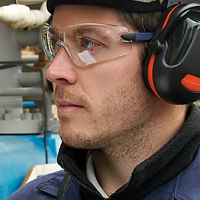 HOW CLEAN IS THE AIR YOU BREATHE?
HOW CLEAN IS THE AIR YOU BREATHE?
Indoor air quality must be monitored to protect workers’ respiratory health. Shawcity highlights the dangers that may be present in every breath you take.
Shawcity is the UK’s leading provider of specialist monitoring instrumentation for health and safety, occupational hygiene and environmental monitoring across a wide range of industries. We offer instruments for gas detection, air quality, dust, sound, noise, vibration and heat stress. (Read More)
Within this remit, indoor air quality is increasingly a pressing issue for many industries, particularly with regard to Volatile Organic Compounds (VOCs).
TOXIC GASES AND DUST
VOCs are often associated with Sick Building Syndrome. Within the indoor environment they constitute the principal class of contaminants that can be found, consisting of a complex mixture of between 50 and 300 different types of compounds.
Advertisement - Hover to see more
Advertisement - Hover to see more
The sources of most VOCs are products used in construction, finishing and cleaning products such as paints, adhesives, sealants, flooring, processed woods and surface finishings. Other sources include furniture, office electronics, personal care/hygiene products and other such materials brought into a building by its occupants. It is also possible for VOC contaminants to be drawn in from the outdoor environment, especially if a building is near roads or industrial activities.
The specific components of interest are recognised as particulates, inorganic gases and organic vapours. Particulates contain polyaromatic hydrocarbons, metaliferous abrasion particles, sulfates and silicates; inorganic gases include oxides of nitrogen, sulphur and carbon; and there is an expansive list of organic compounds, which includes highly toxic compounds such as benzene, butadiene and formaldehyde.
HEALTH EFFECTS
The health effects of many volatile organics are still not fully understood, but in general it is known that the quantity, toxicity and length of time of exposure result in different outcomes. These effects are often associated with symptoms of irritation to eyes, nose and throat, headaches, dizziness, visual disorders and memory impairment.
Little is yet known about the health effects found in public/commercial buildings when mixtures of VOCs are present, but continuing research by private organisations and public bodies is helping to understand the risks posed.
INDOOR ENVIRONMENTS
Indoor environment studies have shown that the ambient total VOC concentration ranges from 0.2 to 5 milligrams per cubic metre of air (mg/m3), with a number reporting some environments reaching up to 25mg/m3. European Community target guideline values of between 0.2 – 0.3mg/m3 have been discussed.
Within the UK, the Building Research Establishment Environmental Assessment Methodology (BREEAM) has set out guideline values for VOCs, semi VOCs and aldehydes. Further to this, BREEAM sets limits on gases – including CO, CO2, NO, NO2, SO2 – as well as particles (mass concentration and size distribution). These are taken post-construction but pre-occupancy so that air quality can be confirmed before a building is put into use.
DIESEL FUME CANCER RISK
Furthermore, with the classification of diesel fume as a major cancer risk (International Agency for Research on Cancer, World Health Organisation) in 2012, diesel fume within enclosed spaces and indoor environments has come into sharp focus. This was reinforced by the Health and Safety Executive’s guidance note INDG 286 “Diesel Engine Exhaust Emissions” in the same year. This now requires any employer under the COSHH regulations to make a “suitable and sufficient assessment of the risks” and “prevent or adequately control the exposure”.
THE BEST MONITORING TECHNOLOGY
As the UK’s leading supplier of monitoring instrumentation, Shawcity has been working alongside a wide range of customers to provide both the expertise and equipment to monitor VOCs, toxic gases and dusts. To enable us to provide the widest range of monitoring solutions, we offer the best available technology from market leaders such as TSI, Sensidyne, Ion Science and Rae Systems.
For more information, please email:
This email address is being protected from spambots. You need JavaScript enabled to view it.
or call the team on:
01367 899419.
www.shawcity.co.uk

